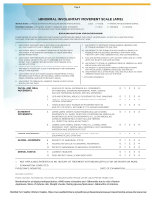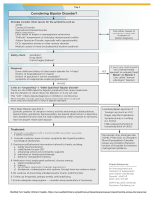Introduction and Overview
The following resources are widely used in clinical settings to screen and assess, design treatment protocol, prescribe medication and provide referrals for children and adolescents with symptoms of Bipolar Disorder.
Screening & Assessment
Flowchart to guide the process of considering, diagnosing, and treating bipolar disorders.
 Abnormal Involuntary Movement Scale (AIMS)
Abnormal Involuntary Movement Scale (AIMS)
Physical exam to assess for Tardive Dyskinesia symptoms. Tardive Dyskinesia causes abnormal movements. Symptoms can be a result of antipsychotic medications.
Treatment
Evidence-Based Treatments for Bipolar Disorder
- Different Types of therapy for Bipolar Disorder: Overview of popular therapeutic interventions for individuals with Bipolar Disorder.
- Bipolar Disorder Worksheets: Designed for therapists.
Referral and Co-Management
NA for this topic
Medication
Risperidone (Risperdal)
- Comes in: 0.5, 1, 2, 3, 4 mg 1mg/ml
- Start at: 0.5 mg
- Titration schedule to effect: Dose may be adjusted if needed, in increments of 0.5 to 1 mg/day at intervals ≥24 hours, as tolerated, to a dose of 2.5 mg/day. Note: May administer 1/2 the daily dose twice daily in patients who experience persistent somnolence.
- FDA approved for age ≥ 10
Aripiprazole (Abilify)
- Comes in: 2, 5, 10, 15, 25, 30 mg 1mg/ml
- Start at: 2 mg QD
- Titration schedule to effect:
- Most common dose range: Max Daily Dose:
- FDA approved for age ≥ 10
Quetiapine (Seroquel)
- Comes in: 25, 50, 100, 200, 300, 400 mg
- Start at: 22 mg BID
- Titration schedule to effect:
- Most common dose range: Max Daily Dose:
- FDA approved for age ≥ 10
Ziprasidone (Geodon)
- Comes in: 20, 40, 60, 80 mg
- Start at: 20 mg BID
- Titration schedule to effect:
- Most common dose range: Max Daily Dose:
- Not approved by the FDA
Olanzapine (Zyprexa)
- Comes in: 2.5, 5, 7.5, 10, 15, 20 mg
- Start at: 2.5 mg QHS
- Titration schedule to effect:
- Most common dose range: Max Daily Dose:
- FDA approved for age ≥ 13
Asenapine (Saphris)
- Comes in: Sublingual 2.5, 5, 10 mg
- Start at: 2.5 mg SL BID
- Titration schedule to effect:
- Most common dose range: Max Daily Dose:
- FDA approved for age ≥ 10
Lurasidone (Latuda)
- Comes in: 20, 40, 60, 80, 120 mg
- Start at: 20 mg QD
- Titration schedule to effect:
- Most common dose range: Max Daily Dose:
- FDA approved for age ≥ 10
Other Medication Options
- Lithium: FDA aprroved age ≥ 7
- Valproate: Not approved by the FDA
- Carbamazepine: Not approved by the FDA
- Lamotrigine: Not approved by the FDA
Billing/Coding
96160
- Can code two per visit
- Code pays $7.91 (at well visit and at E+M visit)
- Examples: Bright Futures Adolescent Supplemental Questionnaire, GAPS, HEADSSS
96127
- Can code two per visit
- Code pays $4.10 (at well visit and at E+M visit)
- Examples: PSC, SCARED, CDI, CES-DEC, PHQ-9 Modified for Adolescents, Vanderbilt, Conners
99408
- May be reported in addition to E/M or Health Check
- Code pays $30.73 (only code if screen is positive & counseling is documented from 3-15 minutes)
- Examples: CRAFFT for Substance Use/Abuse
Additional Resources for Families
There is no shortage of books written about childhood bipolar disorder. Despite this fact, quality research based and balanced information is hard to find. This reflects a professional debate about how bipolar disorder in children is defined, with some authors using “bipolar, unspecified type” as a label for a very irritable child.
Families should start their learning about bipolar disorder with the following websites that provide high quality information and support.
Websites
- American Academy of Child and Adolescent Psychiatry: Practice Parameter on Bipolar Disorder. This contains a very detailed review of treatments.
- American Academy of Child and Adolescent Psychiatry Bipolar Disorder Resource Center: Video clips, “facts for families,” and many other resource links
- National Institute of Mental Health: National Alliance for the Mentally Ill Bipolar Disorder section.
- Depression and Bipolar Support Alliance Parents Med Guide: Contains bipolar disorder medication information from American Psychiatric Association and American Academy of Child and Adolescent Psychiatry.
- Young Minds: Bipolar Disorder
Apps
- iMoodJournal: Daily mood tracking
- Breathe2Relax: Guided deep breathing
- eMoods: This app was designed for people with bipolar disorder to capture daily highs, lows, symptoms, etc., to track mood changes and see monthly reports, identify triggers, and improve care.
- Medisafe: Medication tracking/reminders.
Fact Sheets
- NIMH (2020)’s Bipolar Disorder in Children and Teens: Causes, symptoms, treatment, and more.
- Bipolar Disorder in Children and Teens: A Parent’s Guide
Books
- An Unquiet Mind (1995), by Kay Redfield Jamison, MD (a memoir by a bipolar disorder researcher who had the illness herself — can be helpful for understanding the nature of bipolar disorder)
- Bipolar Disorder for Dummies (2005), by Candida Fink, MD and Joe Craynak (don’t be put off by the name of the book, it is balanced and easy to read)
- The Bipolar Workbook: Tools for controlling your mood swings (2006), by Monica Ramirez Basco (contains some practical advice, based on CBT principles)
- Your Child Does Not Have Bipolar Disorder (2011) by Stuart Kaplan (describes when a bipolar label would not be appropriate, and how we know how to help irritable, angry, explosive children)
- The Bipolar Teen: What You Can Do to Help Your Child and Your Family (2007), by David Miklowitz, PhD and Elizabeth George, PhD
Videos
- Sadie’s story: The tale of a bipolar child
- Raising Sadie: My bipolar child





